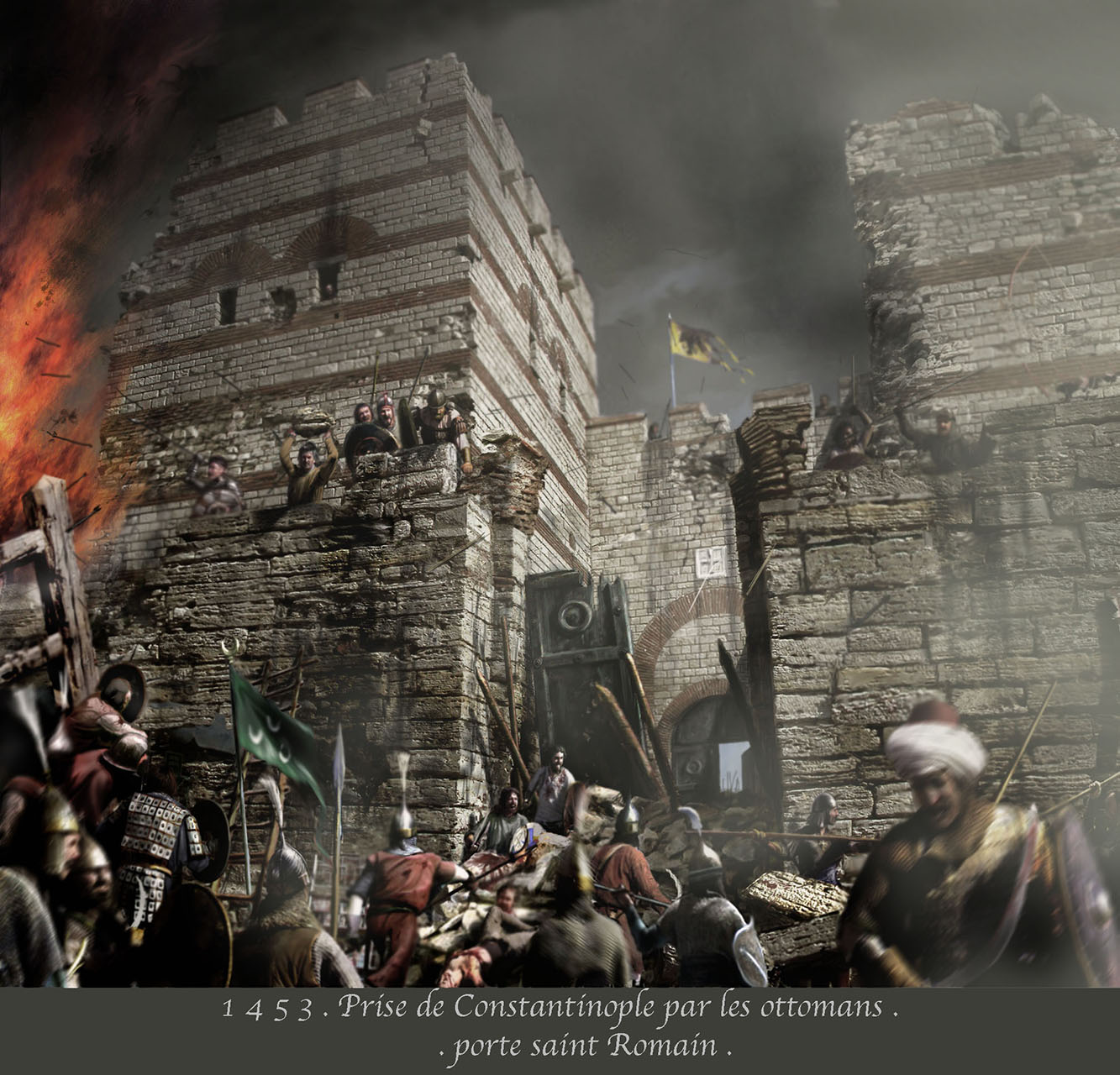 BY EDWIN PEARS, LL.B.
BY EDWIN PEARS, LL.B.
The general assault commenced between one and two hours after midnight on the morning of Tuesday May 29.
When the signal was given, the city was attacked simultaneously on all three sides. The orders given by Mahomet on the previous day had been strictly obeyed. The ships during the night had taken up the positions assigned to them on the sides of the Marmora and on the Golden Horn. The armies on the landward side began simultaneously to attempt the walls at several points.
The principal assault was in the Lycus valley and against the stockade: where, says Tetaldi, twelve hundred feet of barbican had been destroyed by the cannon; where, adds Chalcondylas,402 four of the strongest towers had been destroyed; where, says Ducas, the Outer Wall had been so completely broken down that the besiegers and besieged could see each other, and where, explains Critobulus, the Outer Wall had been so entirely overthrown by the cannon that it was no longer a wall but only a stockade built up with beams, fascines, branches and the like, and barrels of earth.
The defenders were between the stockade and the Inner Wall. Here they had to defeat the enemy in front of them or die. Mahomet’s intention was to concentrate his attack on the stockade and on the walls between the Adrianople Gate and Tekfour Serai and to deal blow after blow against them with the whole of his available force while making sufficient show of attack elsewhere to draw away the defenders.
Assault begun by Bashi-bazouks.
The assault was commenced by the Bashi-bazouks, the most worthless portion of Mahomet’s army, who came up for this purpose from the northern end of the landward walls. Many among them were Moslems, but there were so many Christians and foreigners that Barbaro calls them all Christians. Leonard declares that among them were Germans, Hungarians, and other foreigners of various kinds.405 Mahomet’s object in sending forward these men to make the first attack was mainly that they might exhaust the strength and the ammunition of the besieged. This, indeed, was his method of utilising his superiority in numbers.406 336 Moreover, says Barbaro, he preferred that these Christians should be killed rather than his Mussulmans. The Bashi-bazouks advanced bearing all the scaling-ladders within shooting distance of the walls and probably extended themselves from Tekfour Serai to the stockade and beyond to Top Capou. They began the fight with a general discharge of arrows, of stones from slings, and iron and leaden balls. Then, with a wild disorderly dash, they rushed across the ditch and endeavoured to capture the Outer Wall and especially the stockade. They were armed in ways as numerous and varied as the races and creeds to which they belonged: some with bows, others with slings, with arquebuses or with muskets,407 but most of them simply with scimitars and shields. Hundreds of ladders were placed against the walls and the bravest hastened to climb them. Others, mounted on the shoulders of their comrades, endeavoured to reach the summit or to strike at the defenders. In the darkness of this night attack, made by fifty thousand men, there was soon wild confusion everywhere, but especially in the valley to which for the present the action in my story is confined. At every point the invaders met with a brave resistance. While among the attacking party there were many who had no heart for the fight, there were others who were not deficient in courage, but they had to meet the best soldiers in the emperor’s army, a band of two thousand Greeks and Italians all under the leadership of Justiniani, ‘the incomparable captain, the mighty man and genuine soldier.’
The defenders threw the ladders down, discharged their arrows, fired their muskets and culverins, and hurled down a prodigious quantity of stones. The assailants were so numerous and so crowded together that the missiles of the besieged told heavily against them. The bravest who succeeded in climbing within striking distance were struck down. The resistance was so stubborn that many began to give way. But they had not yet sufficiently served their purpose. Until their strength was exhausted, Mahomet would not consent that they should cease to exhaust that of the defenders. Those who attempted to withdraw found themselves between the devil and the deep sea. A body of Turkish chaouses had been told off with iron maces and loaded whips to drive back any endeavouring to retreat, and behind them again were stationed Janissaries ready with their scimitars to cut down any who should succeed in escaping through the line of chaouses. In this manner the fight was prolonged for between one and two hours.
They are beaten back.
But in spite of all that could be done, in spite of numbers and of courage, Mahomet’s first division was beaten back with many killed and wounded. Having served its purpose in exhausting the strength of the small body of the defenders, it was allowed to withdraw. Some of the besieged appear to have considered the attack rather as an attempt to surprise the city by a night alarm than as part of the expected general assault. They were indeed weary with hard fighting and hard work. For forty days they had hardly known a single hour of rest, and they hoped for it, at least until the morning. They were soon undeceived.
Anatolian division next attack.
Amid the darkness of the early summer morning a division of Anatolian Turks could be distinguished pouring over the ridge on which stands Top Capou. It was the advance of disciplined men, distinguishable by their breastplates, and their arrival made the situation much more serious. Here, indeed, was the general assault which all expected at daylight. The bells throughout the city again sounded everywhere an alarm; all the inhabitants were at their posts. As the Anatolians came across the ditch up to the stockade the struggle began once more in deadly earnest. Trumpets, fifes, and drums sounded their loudest to encourage the assailants. Besiegers and besieged shouted and roared at each other. Prayers for help, imprecations, clang of bells within the city, roar of guns and small cannon within and without made up the pandemonium of a storming party. Ladders were once more placed against the walls and were hurled back; men scrambled on each other’s shoulders trying hard to reach the summit of the stockade. ‘Our men’ are continually throwing down stones and are resisting hand to hand all who attempt to scale or destroy it. ‘More Turks were killed,’ says Barbaro, ‘than you would have thought possible.’
Now the great cannon, which during the night had been advanced as near the wall as possible, is brought into play. An hour before daylight a well-directed shot from the monster was aimed at the stockade, struck it and brought a portion of it down. Under cover of the dust from the falling stones and barrels of earth, but especially of the dense black smoke of the powder, a band of Turks rushed forward and, before they could be prevented, three hundred had entered the enclosure. The Greeks and Italians resisted manfully, fought fiercely to expel them, killed many and drove the remainder out. The besieged raised shouts of triumph. The emperor was with his soldiers, always showing himself in the thick of the fighting, urging men by voice and cheering them by his example. This second attack was more systematic, fiercer, more desperate than the first. The Turks had no need of men behind them to prevent their retreat or to urge them forward. Shouting their wild battle-cry of Allah! Allah! they rushed on in the darkness as men who, if they do not court death, at least do not fear it; as men who believe they are fighting for God, and that in case of death they will be at once transported to a combined heavenly and earthly paradise.
They, too, are driven back.
In spite of the discipline and daring of the Anatolian troops, of the stimulus derived from their fanatical creed and from the special promise of reward here and hereafter to those who should succeed in entering the Queen City or should perish in the attempt, the assault by them failed as completely as had that of the Bashi-bazouks. The 339stubborn bravery of a comparatively small number of Greeks and Italians behind the hastily formed stockade and the battered, thousand-year-old walls were so far more than a match for the invaders.
Assaults in other places also fail.
The success of the attackers was up to the present not more complete in other parts of the city. Zagan Pasha had made desperate attempts to scale the walls near the west end of the Horn under cover of showers of arrows and other missiles from the ships and from large pontoons drawn up as near as possible to the walls, but had been defeated by Trevisano. Caraja Pasha, north of the Adrianople Gate, had crossed the foss and made a vigorous attempt against the walls broken down by the cannon between that Gate and the Palace of Porphyrogenitus, now known as Tekfour Serai. But that district, ‘the high part of the Myriandrion,' was held by the three brothers Bocchiardi, who had borne the cost of their men at their own charge, and who covered themselves, says Leonard, with eternal glory, fighting like Horatius Cocles and his companions who kept the bridge of old. Their neighbours at Tekfour Serai and around the southern portion of Caligaria under the Venetian bailey Minotto, had been equally successful. All the invaders’ attempts had been defeated. Critobulus is justified in commenting with pride on the defeat of this second attack. ‘The Romans, indeed, proved themselves very valiant; for nothing could shake them, neither hunger nor want of rest, nor weariness from continuous fighting, nor wounds, nor the thought of the slaughter of their families which menaced them. Nothing could alter their determination to be faithful to their trust.’
There remained but one more chance—on May 29 at least—of capturing the city by general assault. Two divisions had failed. But Mahomet noted that his plan of attack by successive divisions had greatly weakened the defenders at the stockade. He therefore decided to put forth all his strength and to send forward his reserves.
These consisted of the élite of his army, the veteran warriors of his bodyguard, infantry bearing shields and pikes, a body of archers, another of lancers, and, more skilled and more Assault by Janissaries. trustworthy than all, his body of twelve thousand Janissaries. These reserves were now to attempt the assault at the stockade under the immediate leadership of their great commander, while the remainder of the army made a simultaneous attack against other portions of the landward walls.
Mahomet began the new assault with the utmost care. Dawn was now supplying sufficient light to enable him to superintend a more elaborate plan. The assault was not to be a mere wild rush and scramble. Having urged his guards to show their valour, Mahomet put himself at their head and led them as far as the foss.
At the moment, says Barbaro, when the defenders were rejoicing at having driven out the three hundred from the barbicans, the pagans again fired their big gun and under cover of the smoke and dust the besiegers advanced. A huge but orderly crowd of archers, slingers, and musketeers discharged their arrows and other missiles. Successive volleys were steadily fired upon the Greeks and Italians defending the whole length of the stockade, so that they could hardly show a head over the battlements without being struck. The missiles fell in numbers, says Critobulus, like rain. They darkened the sky, says Leonard. When the defenders had been thrown into some confusion by this long hail of missiles, Mahomet gave the signal for advance to his ‘fresh, vigorous, and invincible’ Janissaries. They rushed across the foss and attempted as their predecessors had done, to carry the stockade by storm.
Ten thousand of these ‘grand masters and valiant men,’ says Barbaro, with admiration for a brave enemy, ‘ran to the walls, not like Turks, but like lions.’ Fighting in presence of their sovereign, says Critobulus, they never lost their dash, but fought like men possessed and as if life were of no value. They tried to tear down the stockade; to break or pull down the great barrels of earth which crowned it; to drag out the beams and thus break down or make a passage through into the Enclosure; to climb over it on the scaling-ladders which once placed against the wall were immediately crowded with assailants. Their shouts and yells, their calls upon Allah, the noise of their drums, fifes, and trumpets, the roar of the culverins and cannon once more struck terror into the affrighted citizens and were heard, says Barbaro, across the Bosporus. For a while all was mad confusion.
We do not need the confirmation of Barbaro and Critobulus of the statement that the Greeks and Italians were worn out with their long defence before the attack by the Janissaries commenced. They had been hewing and hacking, throwing down stones and hurling back ladders for nearly, or perhaps quite, three hours and were unequal to contend with many times their numbers of men ardent and fresh for battle. But they knew, as indeed did every one within the city, that the crisis of the attack was at hand, and they manfully fought on. The church bells added to the din: the alarm bells on the walls were calling for every available help. Women and children, monks and nuns, were either assisting to bring stones to their friends on the walls or were on their knees praying that their great city should not fall into the hands of the pagans. Justiniani and his little band met the attack with lances, axes, pikes, and swords, and cut down the foremost of their assailants. For a short time the fight became a hard hand-to-hand encounter, neither party gaining any advantage over the other.
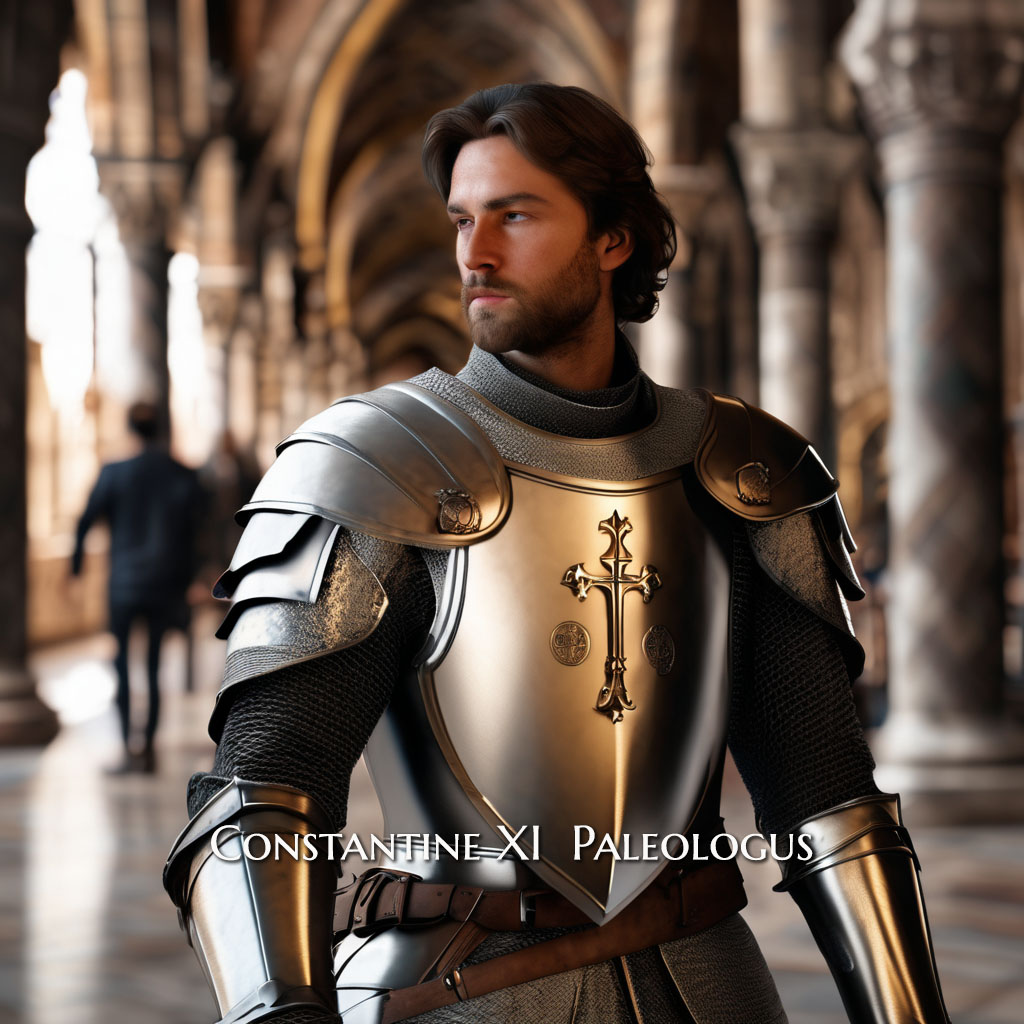 The Kerkoporta incident.
The Kerkoporta incident.Contemporaneously with this latter portion of the struggle in the Lycus valley, an incident, possibly of supreme importance, was taking place about half a mile to the northward.
Of the three ways into the city which Mahomet declared he had opened for his troops, one was to the north of the Adrianople Gate. The walls between this gate and the Palace of Porphyrogenitus were, in construction, like those in the Lycus valley, but the inner Theodosian wall, instead of extending as far as that palace (now known as Tekfour Serai), stopped short about a hundred yards from it. There a short wall at right angles connected it with the second or Outer Wall. In this transverse wall was a postern giving access from the city to the Inner Enclosure or Peribolos. The short Outer Wall north of the transverse wall, having to do duty for the two city walls, had been made exceptionally strong. A small postern gate, partly below the level of the ground and underneath the extremity of the palace, led directly from the city to the Outer Enclosure. This gate was known as the Kerkoporta or Circus Gate.419 It had been built up and almost forgotten for many years previous to the siege, but when easy access to the Outer Enclosure was deemed necessary, certain old men recalled its existence and it was reopened. As its position caused it to be concealed from persons who were not close to the tower, it may easily have been left undefended for a while during the night under the impression that it would not be noticed.
The Outer Wall between the Kerkoporta and the Adrianople Gate had been largely damaged and a breach made which had been stormed unsuccessfully during the night. The Turks had here also, as well as near the Romanus Gate, been able to pass the ditch and take possession of the Outer Enclosure.
As daylight approached, some of the enemy noticed that the Kerkoporta had been left open. A number of Janissaries (stated by Ducas to be fifty) hastened through and took possession of it. They were soon followed by others, who gained access to the Inner Enclosure first through the Kerkoporta and then through the neighbouring postern already mentioned in the transverse wall, the distance between the two posterns being about thirty yards. They surprised and attacked those who were occupied in resisting the attempts of Caraja’s main division to storm the breach or scale the Outer Wall. Every foot they captured allowed their numbers to be increased by comrades who could now climb the Outer Wall without opposition or who crowded in through the Kerkoporta and the postern in the transverse wall. The besieged, overwhelmed by numbers, and having their retreat into the city through the postern cut off, fled towards the Adrianople Gate, the postern of which was soon blocked by the crowd, the stronger trampling upon the weaker, so that presently all egress from the Enclosure was impossible. A slaughter took place and a few Turks entered the city, while others mounted the walls, pulled down the emperor’s flags and those of St. Mark and replaced them by the Turkish standards.
The entry of the Turks by the Kerkoporta is only related by Ducas, but it is incidentally confirmed by the fact mentioned by Phrantzes and other writers, that while the struggle in the Lycus valley was going on, the Turkish standards were raised on the towers to the north of the Adrianople Gate before an entry had been effected elsewhere. Critobulus’s statement that Caraja’s men crossed the foss, made a vigorous assault, and sought to pass within the broken-down (Outer) wall, but were repulsed, probably refers to the same incident. Ducas is careful to state that the emperor and the Romans did not know what had happened, because they were at some distance and were too much occupied in defending themselves in a different place, which he explains to be where the wall had been broken down: that is, at the stockade in the Lycus valley. While they were thus fighting, he says, to resist the entry through the ruined wall, God willed that the enemy should enter the city by this other way. Leonard mentions that the arrangements for sending messengers from one part of the wall to another were defective. The emperor, however, was probably informed of the entry by the Kerkoporta and of the capture of at least part of the enclosure between that postern and the Adrianople Gate, and hastened thither before his army under Justiniani learned that the Turkish standards had been hoisted on the towers near the Adrianople Gate. The few Turks who had entered the city, bent upon plunder, made for the rich monasteries of Choras and St. John in Petra and the Blachern palace; but it would appear that the brothers Bocchiardi were able to regain possession of the Enclosure and to prevent any considerable number of the enemy from following those who had entered the Kerkoporta. Possibly even they were strong enough to close it. The fact that the entry at the Kerkoporta is not mentioned by Critobulus may be taken to confirm the view that, if he knew of it at all, he only regarded it as a somewhat unimportant incident.
Meantime in the Enclosure in the Lycus valley the struggle was being bravely fought out with pikes, axes, javelins, long lances and swords, for now, as Critobulus is careful to inform us, ‘the fight was hand-to-hand.’424 The obstinate resistance of the little band of Greeks and Italians appears to have met with some success. The attack by the Janissaries and the rest of the sultan’s own division had so far failed and was weakening.
John Justiniani wounded.
It was at this moment that one of those fateful accidents occurred which have at times decided the destiny of nations. John Justiniani, who under the emperor was in supreme command, was severely wounded. He bled profusely, and determined to leave his command in order to obtain medical aid. The wound was so severe that it proved mortal within a few days. But those present did not recognise its gravity. Some of his contemporaries deny that it was sufficiently grave to justify his leaving the field, but Critobulus, writing some years afterwards, states that he had to be carried away.425 Leonard and Phrantzes say that when the emperor was informed of his determination to enter the city, Constantine besought and implored him not to do so but to return to his post, endeavouring to persuade him that the wound was slight and pointing out that his departure would demoralise not only his own men but the Greeks, and strongly urged that the fate of the city depended on his remaining. Justiniani, however, pleaded the pain of his wound, demanded that the key of the gate leading into the city should be given to his men,426 and insisted upon leaving the Peribolos or Enclosure, promising to return when his wound had been attended to. The keys of a small gate which Justiniani had caused to be opened in the Inner Wall to give easier access to the Enclosure behind the stockade were brought and he entered the city.
The story told by Chalcondylas is that in reply to the emperor’s question whither he was going, Justiniani said that he was going where God Himself had opened a way for the Turks. It may well be doubted. He was accompanied, say Critobulus and others, by his own men, a statement, however, which can hardly apply to the whole four hundred. The unlocking of the gate proved at once to be a dangerous temptation to soldiers who had been fighting continuously for hours and who had seen the departure of their leader. Justiniani made his way to his ship, which was stationed at the boom, and escaped to Chios, where he died within a few days—or possibly on the way thither.428
Justiniani’s departure creates a panic.
His departure was calamitous and at once created a panic. He was a commander who had the full confidence of those under him, and his absence struck dismay into their hearts. Barbaro says that it was through his flight that the shout was then raised, ‘The Turks have got in;’ that everybody then cried in alarm to God for mercy, and that men wept like women. It was through him, and ‘he lied in his throat, because they had not yet got in.’429 Leonard, himself a Genoese, who speaks of Justiniani with warm admiration, is hardly less severe upon him in regard to his manner of leaving the fight. He declares that, as he had at first shown courage, now he displayed cowardice. He ought to have borne the pain and remained, or at least to have appointed some one in his place. The spirit of his followers was broken by his desertion. The Podestà of Pera, also a Genoese, seems himself to have condemned his departure. He says the enemy was opposed right manfully, but Justiniani deserted his gate, and withdrew to the sea, and by that gate the Turks entered without resistance. Remembering that this is the testimony of the chief Genoese official against the great Genoese captain, it may be regarded as reflecting the general opinion of the time.430 We, however, may well remember that Justiniani had remained in the city with his men, had worked day and night at the repairs of the walls, had, by the testimony of all, been the great organiser of the defence, and, knowing that he died of his wounds, may be charitable enough to believe that he did not desert his post except under the pressure of pain too great to be endured.
It is beyond doubt that his departure demoralised both the foreigners who remained and the brave little band of Greeks who had borne with them the brunt of the fighting. Leonard asserts that when his countrymen saw themselves without a leader, they began to abandon their posts.
Emperor tries to rally defenders of stockade.
Meanwhile the emperor, behind the stockade, was endeavouring to rally his men, and fighting with a courage 348worthy of his great name. He himself took the post of Justiniani and led the defending party. He had no other men to replace those who had left, but he rallied the Greeks and the remainder of the Genoese and Venetians, and with his own small bodyguard rushed to the stockade.
Final charge of Janissaries.
Mahomet witnessed, from the opposite side of the foss, the demoralisation caused by the departure of Justiniani. He noted that the stockade and broken walls had fewer defenders, that many of them were secretly slipping away, and that those who remained were fighting less vigorously. He saw that the opportune moment for him had come and, calling out to his men, ‘We have the city: it is ours already; the wall is undefended,’ urged his Janissaries to fear nothing, but follow him, and the city would be captured. At his bidding and under his lead, the Janissaries hastened once more to rush the stockade and to climb upon the débris of the wall destroyed by the gun.432
The sultan had promised great rewards to the first who should gain a position on the wall. A stalwart Janissary named Hassan gained this honour. A man of gigantic stature, he was able, while holding his shield in his left hand, to fight his way to the top of the broken wall, and was followed by some thirty others. The Greeks resisted their entry and killed eighteen. But Hassan maintained his position long enough to enable some of his followers to climb up and get over the wall. A fierce skirmish took place, and many were killed on both sides. Hassan himself was wounded by a stone, slipped and fell, fought bravely on his knees, but was overpowered and killed. But the discrepancy in numbers was too great. Once a few were able to maintain their position on the wall, the Turks mounted and got over to the inner side of the stockade in crowds. The remnant of the defending army stood their ground for a while, but the invaders drove a number of them back and into the deep ditch which had been dug between the great wall and the stockade and out of which it was difficult to escape. Many were thus killed within the Peribolos, of which for the first time the Turks were now the masters. Some of the invaders climbed the great wall behind the defenders to hurl down stones on them, and a fierce fight went on along the length of the stockade in the Lycus valley, and possibly indeed along the whole length of the walls in the Mesoteichion. Suddenly, in this the supreme moment of the struggle, shouts were heard both within and without the walls and from the direction of the harbour, shouts which were taken up by the Greeks, Ἑάλω ἡ πόλις: ‘the city is taken; the Turkish flags are flying on the towers.’
We have already seen what had happened to cause this cry to be raised. The detachment of Turks who had gained entrance through the Kerkoporta had captured some of the lofty towers between it and the Adrianople Gate, and had there raised the Turkish standards.
‘“The city is captured!” the cry sent dismay into the hearts of our men, but encouraged the enemy.’ It was not true, says Barbaro. The city was not then taken. But meantime the Turks were now up and over the walls in crowds. Within a quarter of an hour, says Barbaro, of their first obtaining possession of the stockade there must have been thirty thousand of them within the Peribolos.
Stockade captured.
The success of the Janissaries in overcoming the first serious line of defence436 was followed up instantly by the other Turkish troops. The news of the entry across the stockade seems to have spread like wildfire, and though it is difficult to believe the statement of Barbaro that the Enclosure was filled from one end of the walls to the other with seventy thousand of the hostile army, it is possible that the vigour which follows success enabled the Janissaries and other portions of the army to obtain entry at once into the Enclosure at various other places. Some of the defenders fled in panic and made for the small gate through which Justiniani had retired, the only one behind them which was open. They rushed on in such haste as to trample each other down.
At this moment the emperor, who had been called off to the northern end of the valley to learn the meaning of the display of the Turkish flags and to resist the inrush of the invaders who had entered by the Kerkoporta, returned. Spurring his horse, he galloped down the Enclosure to the stockade where the Turks were crowding in, and tried to rally the remainder of the defenders. Calling upon his men to follow him, he threw off his imperial insignia, drew his sword, sprang into the thick of the fight, and attempted to Death of Constantine. drive the invaders back. With Don Francisco of Toledo on his right, Theophilus Palaeologus and John Dalmata on his left, his own sword broken, he endeavoured to check the advancing crowd. Theophilus shouted that he would rather die than live. The four checked for a moment the inrush of the Turks, slew some of them, and cut their way to the wall where the Turks were pouring in. But they were hopelessly outnumbered. The emperor was lost sight of amid the crowd. He and his companions fell fighting, and the enemy continued to pour through the breaches.439
Once the enemy had obtained entrance into the Enclosure the defenders were in a trap. The only exit into the city open to them was by the small gate through which Justiniani had passed. The Military Gate of St. Romanus, the Gate of the Assault, remained locked. A heap of slain, Genoese and Greeks,440 near it made escape impossible. The defeat of City captured May 29. the survivors of the gallant band which Justiniani had led was forthwith completed by a body of the Janissaries who entered the Enclosure across the broken stockade, formed themselves in regular order, and swept everything before them.441 Their overwhelming numbers soon enabled them to kill all opponents who had not escaped into the city. The great wall being partly broken down and without 351defenders, and the Gate of St. Romanus being forced or opened, access to the city was easy. A band made their way to the Adrianople Gate, which they opened from the inside, and the city was from that moment in the power of the enemy.442
As the sun rose Mahomet saw that his great effort had succeeded. Where Arabs, with even greater numbers than he commanded, in the first flush of the victorious career of Islam, with the presence of the great Eyoub, the companion of the Prophet, to encourage them and to speak of the wondrous rewards which Paradise had in store for the believers who should enter New Rome or die in the attempt; where Murad thirty years before; and where twenty other besieging armies had been unable to capture the world’s capital, he had succeeded. Seated on horseback beneath his great standard and insignia, he watched with the legitimate pride of a conqueror the entry of his hordes into the city.443 The morning sun shed its rays upon him and his standard as his soldiers thronged through the Gate of the Assault or hastened towards that of Adrianople. The entry was not long after sunrise and probably between five and six o’clock.444
Capture of city due to two accidents.
If credit is to be given to the story of the entry of the Turks at the Kerkoporta as related by Ducas, then it may be said that the capture of the city was due to two accidents: the leaving open of that gate and the wound of Justiniani. It is beyond doubt that the immediate cause of the capture was the withdrawal of John Justiniani, followed by the flight of a considerable number of his men.
In the words of Cambini, a contemporary of the siege, but writing at a sufficiently remote period to look calmly upon the events he narrates, Justiniani had so conducted himself that, until he was wounded, every one looked to him for the salvation of the city, and upon his quitting the battlefield the courage of those whom he led failed them.
Whatever hypothesis as to the character of his wound be accepted, whether when urged by the emperor he could have remained or not, his departure was an irretrievable misfortune. Few as were the defenders when compared with the great host attacking, they had never altogether lost hope. The Podestà of Galata, writing within a month of the capture of the city, declares that he and the Genoese longed for the general attack, because victory for the Christians appeared certain.445 On the other hand, there is reason to believe that the besiegers were far from confident of being able to capture it. There was, as we have seen, a strong peace party in Mahomet’s camp headed by Halil Pasha. The reports were well founded of a fleet in the Archipelago on its way to the city. Thirty ships sent by the pope had arrived at Chios and were awaiting favourable winds at the time they heard of the success of Mahomet.446
There were rumours of a Hungarian army coming to attack them in the rear. The emperor had promised to give Selymbria to Hunyadi in return for his aid. Some inkling of the arrangement may have reached the sultan. The king of Catalonia had made an agreement with Constantine in return for the island of Lemnos.447 It is in the highest degree probable that Mahomet believed that if any of these forces should arrive before Constantinople either by land or by sea, he would have to abandon the siege. With these possible dangers threatening him, it is not unreasonable to conclude that if the besieged could have succeeded in repulsing the Turks in their greatest attack, and have held the city for even one day longer, Mahomet himself would have considered it necessary to withdraw his army, and Constantinople might possibly have been saved for Europe. Hence the withdrawal of Justiniani was an event of supreme importance. It led to the capture and decided the fate of the city, and gave the death-blow to the Eastern Empire. The ships bringing help, which were on their way, were too late. One is almost driven to the belief of Pusculus, ‘Auxilium Deus ipse negavit.
Death of Constantine.
In the struggle which took place, the emperor bore a part worthy of his name and of his position. He perished among his own subjects and the remnant of the Latins who were aiding him. Whether the story related by Ducas and Leonard, that the emperor asked if there was no Christian willing to kill him, be true or not, there can be no doubt that he met his death like a brave man. All accounts attest his courage. Critobulus states that when he saw that the enemy had succeeded and were pouring through the breaches in the walls, he shouted, ‘The city is taken and I am still alive,’ and thereupon dashed into the midst of the enemy and was killed.449
Manner of his death.
The manner of his death is, however, doubtful. No contemporary writer was present. Phrantzes, who had attended him at and after midnight, expressly tells us that he had been sent on duty elsewhere. Critobulus states that the emperor fell near the postern which Justiniani had opened from the city to the stockade; Leonard, that he was struck down by a Janissary, recovered himself, was again struck down and killed.451 Ducas declares that two Turks claimed to have killed the emperor and to have taken his head, which was recognised by Notaras, and that it was placed on a column in the Augusteum, then stuffed and sent to be shown in Persia, Arabia, and Asia Minor.452 The story of Ducas is to a certain extent confirmed by the Moscovite, who states that a scribe brought the head of the emperor to Mahomet, who, when he was assured that it was genuine, kissed it and then sent it to the patriarch. It was then encased in a silver vase and buried under the altar of St. Sophia. He adds that the body was carried in the night to Galata and there buried.453 To some extent their story is confirmed by Pusculus, who says that in struggling with the Janissaries ‘at the mound,’ where he killed three Turks, he was slain by the mighty stroke of a sword; that his head was cut off from his shoulders by one who knew him, and taken to Mahomet, who paid the promised reward.454 None of these stories as to the manner of death can be regarded as altogether trustworthy. Barbaro, with the sailor-like bluntness which usually characterises his matter-of-fact statements when not attacking the Genoese, says, ‘No news was received of his fate, whether he was living or dead, but some say that his body was seen among the number of the dead, while others asserted that he was trampled to death at the entry which the Turks made at the gate of St. Romanus.’ Phrantzes, who, like Barbaro, was in the city at the time, records that, after the capture, the sultan caused diligent search to be made to learn whether the emperor was alive or dead; that men were sent to seek among the heaps of the slain; that many heads were washed, but no one could recognise that of the emperor; but that a body was found which had the imperial eagles embroidered on the socks and greaves, and that this body was given over to the Christians to be buried with due honours. Phrantzes does not profess to have seen the body, and makes no mention of the head having been brought to the sultan and recognised by Notaras the Grand Duke, as stated by Ducas. Tetaldi confirms the statement that the emperor died at the time of the assault. He adds, ‘Some say that he had his head sliced off; others that he died at the gate en s’en cuidant yssir. Either story may be true. He died in the throng, and the Turks would have cut off his head.’
Against the version of Phrantzes is to be placed the fact that his tomb is unknown and that no contemporary—or, indeed, subsequent—writer mentions where it was. Had it existed, it is not likely to have been forgotten by the Greeks. Had the body been purposely buried in a secret place, there would probably have grown up a legend about it which would have kept its memory green.456
Character of Constantine.
Constantine Palaeologus Dragases in the fiftieth year of his age disappears amid the final charge of the Turkish Janissaries. Although there were rumours of his escape, his death within the Inner Enclosure of the Lycus valley cannot reasonably be doubted. His conduct during the whole of the siege had earned respect. He had done his best to encourage his subjects to fight bravely, had stimulated them by his speech and by his example. He had spared no exertion day and night to organise the defence, had tried to reconcile hostile parties and to unite all for the common safety. When the long-standing jealousies and rivalries between his own subjects and the citizens of the two republics threatened to weaken the force available for the defence of the city, it was he who by his personal influence and the respect and even affection which he had acquired and inspired persuaded them to postpone their quarrels. Fanatical Greeks and equally fanatical Catholics had almost forgotten for the time their animosities and had joined forces for the honour of God and for the defence of Christianity. At his instigation, Roman cardinal and Orthodox bishops had thrown themselves energetically into the common labour of resisting the Moslem hordes. At his entreaty the task of completing the Union of the Churches was by common accord allowed to stand over. The example of the religious chiefs was followed by their flocks. Whenever we are able to get a glimpse of the emperor’s personality we see him as a man without conspicuous ability but whose devotion to his country was complete, whose sympathy made friends of all who were brought into contact with him, and won for him the admiration of his own troops and of the brave Italians who fought under him. His refusal to leave the city when urged to do so by the patriarch and other leaders both of the Church and people was the more praiseworthy when it is remembered that the arguments in favour of departure were at least plausible, and that he had apparently come to the conclusion that, in spite of all his exertions, Mahomet would succeed in capturing it.
He was holding the last great stronghold of Eastern Christianity against the attempt of Islam to capture that which in the eyes of all Moslems represented the capital of Christendom. The steadfastness and tenacity with which the imperial city had maintained its lordship for upwards of a thousand years and had during the whole of that period served as a bulwark against the invasion of Europe by Asiatic hordes were worthily represented in its last emperor. Various causes, for which he can in no way be held responsible, had sapped the strength of the city and made its capture possible, but with a Roman obstinacy that would have done honour to the best of his predecessors he deliberately chose not to abandon it but to die in its defence. To his eternal honour it must be said that, despairing of or not considering the question of ultimate success, he never wavered, never omitted any precaution to deserve victory, but fought on heroically to the end and finally sacrificed his life for his people, his country and Christendom. The exact spot where he lies buried is unknown, but, in the bold metaphor, quoted as already old by the great consort of Justinian, he judged that ‘the empire was an excellent winding-sheet.’457 His death was a fitting and honourable end of the Eastern Roman Empire.
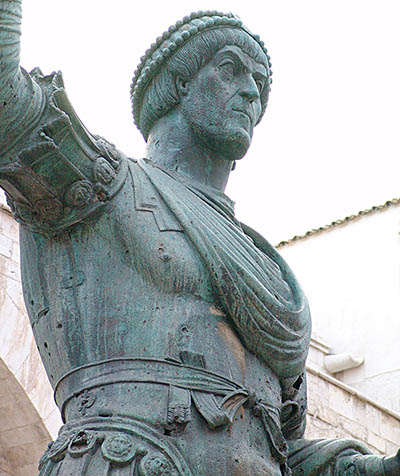 Bente Kiilerich has written an extensive monograph on the colossus - the following is the abstract and her conclusion, which I downloaded from academia.edu:
Bente Kiilerich has written an extensive monograph on the colossus - the following is the abstract and her conclusion, which I downloaded from academia.edu: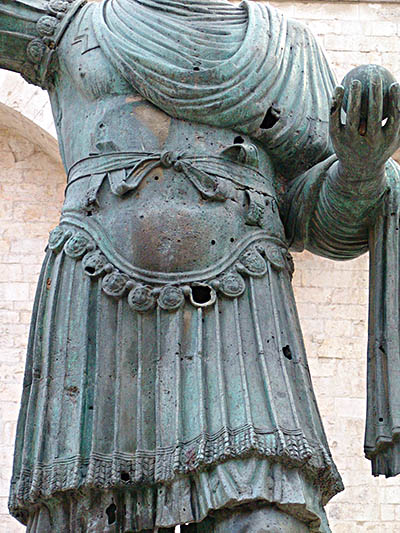
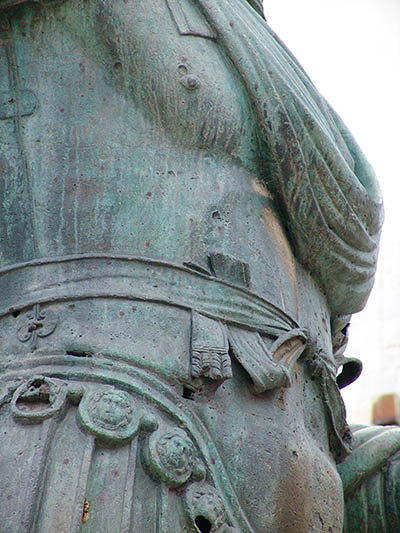
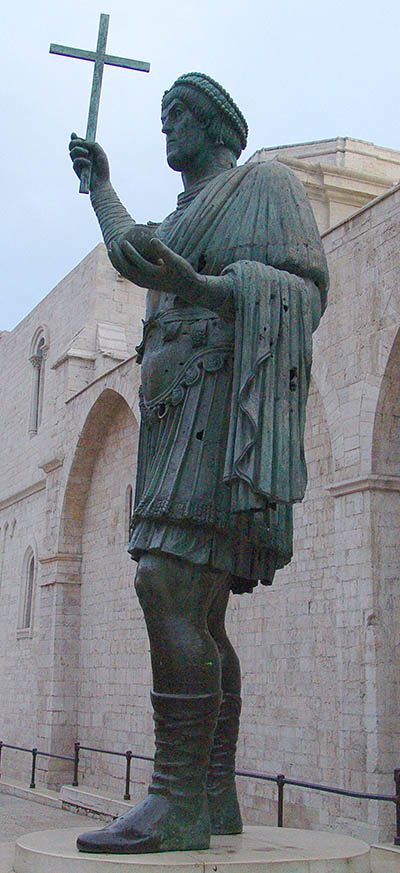 Below is a photo-montage of the Colossus placed on the Column of Marcian
Below is a photo-montage of the Colossus placed on the Column of Marcian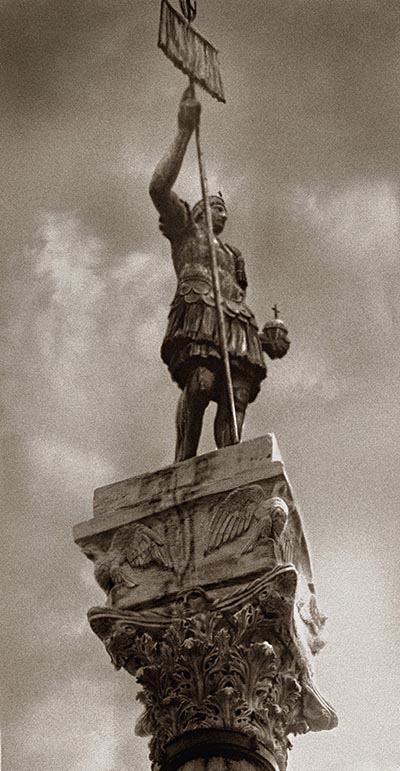
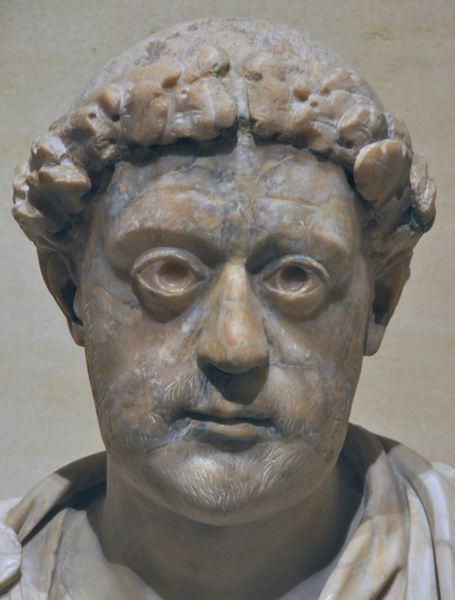

 BY
BY  The Kerkoporta incident.
The Kerkoporta incident.



 click here for icons of christ
click here for icons of christ click here for icons of the theotokos
click here for icons of the theotokos click here for icons of angels
click here for icons of angels click here for icons of saints
click here for icons of saints








